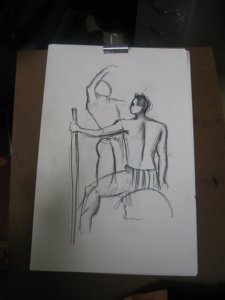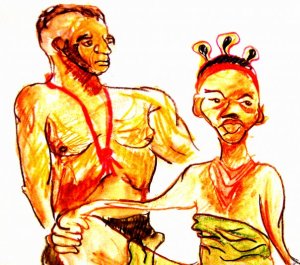by Christine Balmes
 The art model and the drawer are interested in the same things: how the body moves, how it expresses, how it communicates. Last Friday I sat for a group of artists for the life drawing circle at Kapisanan. I had no idea what to expect. How will it feel to be stared at, to be studied in minute detail? Will they see all the little blemishes on my skin? Will I project this bad posture I get into when I think no one's looking?
The art model and the drawer are interested in the same things: how the body moves, how it expresses, how it communicates. Last Friday I sat for a group of artists for the life drawing circle at Kapisanan. I had no idea what to expect. How will it feel to be stared at, to be studied in minute detail? Will they see all the little blemishes on my skin? Will I project this bad posture I get into when I think no one's looking?
So I was a little scared going in. A little scared, but not a lot. I had been increasingly interested in the work of the art model, in the work of the artist because of this book I picked up. Drawing is learning how to see. And modeling is learning how to show. And, for an artist--even an artist whose forte is in writing, the least performative of all the arts out there--it is important to be able to project.
Well, it turns out I had nothing to worry about. Perhaps because I knew that I was going in there as a model and not as myself, it was easy to detach. Perhaps it was all the jewelry and cultural artifacts Jodee (who also modeled) put on me: it wasn't me up there anymore, I was just a vessel. I was just a body representing an idea. Perhaps too, it was easy because I'm a Filipino. How many times have I been forced to pose for a photograph, asked to pick up the MagicSing mic, or made to perform my musical instrument for the entertainment of house guests? Easy peasy.
 I learned a few things from this experience. One: it's painful to hold a pose for so long. But your body learns. At one point I put my arms down, thinking and hoping it was time to change my pose. It wasn't. I raised my arms back up and my limbs automatically found that bittersweet spot of pain and remembrance. Two: the body communicates in ways that words cannot. Gestures, emotions, poses are impossible to describe exactly in words. Only the visual image of the body can convey these things accurately. Three: the most important thing is to communicate, and to be always present. You are not allowed to get bored. Four: your work as a model is to express. The work of the artist is to see this expression and capture it. It's a two-way process. So when you see the final product it's not just an issue of accuracy. It's also an issue of documenting the communication that took place.
I learned a few things from this experience. One: it's painful to hold a pose for so long. But your body learns. At one point I put my arms down, thinking and hoping it was time to change my pose. It wasn't. I raised my arms back up and my limbs automatically found that bittersweet spot of pain and remembrance. Two: the body communicates in ways that words cannot. Gestures, emotions, poses are impossible to describe exactly in words. Only the visual image of the body can convey these things accurately. Three: the most important thing is to communicate, and to be always present. You are not allowed to get bored. Four: your work as a model is to express. The work of the artist is to see this expression and capture it. It's a two-way process. So when you see the final product it's not just an issue of accuracy. It's also an issue of documenting the communication that took place.
I also mentioned this book that I picked up beforehand. The Undressed Art: Why We Draw by Peter Steinhart is a really good book that discusses drawing and art modeling. I recommend it for anyone who's interested in seeing, in performing, in art, in communicating. Here are some tips I picked up from there for anyone who's considering art modeling in the future:
1. Part of a model's professionalism is being able to recognize how much or how little distance to keep between themselves and the artists. 2. Sit still. Concentrate on your pose. 3. A model has to fit his or her feelings to the group's feelings. 4. Be confident, but don't show off; share the space. 5. The model must be empathic towards the artists. 6. The model has to lead. She is the writer, director and actor all at once. 7. The model sets the mood. She is responsible for charging up the artist. 8. But, still, modeling and drawing are collaborative. 9. Modeling is painful. When you hold your pose for long periods at a time, your circulation is cut off, things start to hurt, shake, and collapse. So choose your pose strategically. Make decisions based on how long your pose will be held. 10. The artist and the model are both concerned about the same thing: how the body moves and how it communicates. 11. Some poses you can do: 5 different poses held for 2 minutes, a couple of poses held for 15 minutes, 3 poses held for 10 minutes, a 3 hour pose. 12. In modeling it is possible that you will develop an appreciation for what doesn't fit the stereotype. You will develop a level of comfortability with yourself and with other human beings. 13. Do not box in or crumple your body. Most of all you want to create interesting poses that will attract the artist and energize them to draw. 14. The energy and mood you bring has an effect on the atmosphere of the room. So if you arrive in a bad mood and with a negative energy, it might drive off the muse, not to mention the artists. Keep this in mind when you make your first pose. 15. The body is breathtaking. It is full of expression. Explore this in your work.
